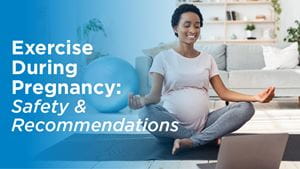
Physical activity and regular exercise during pregnancy can be beneficial to the health of both the mother and baby. Certain, low-impact exercises have a variety of health benefits, while more intense activities may be risky.
What exercises are safe for you and your baby? We asked Rochester Regional Health midwife M. Robin MacIntyre, MSN, CNW common questions about safe exercises and how to stay active while pregnant.
Regular exercise throughout pregnancy can reduce back pain, ease constipation, and may decrease risk of gestational diabetes. Routine exercise while pregnant can improve posture and reduce discomfort like back pain and fatigue. Exercise can also reduce stress and build more stamina to prepare for labor and delivery.
Participating in physical activity promotes healthy weight gain, improves overall fitness, and strengthens your blood and heart vessels. Routine exercise may even reduce the risk of cesarean section delivery. MacIntyre recommends walking as a, “great form of exercise in all three trimesters of pregnancy, as well as post-partum.”
In moderation, most exercises are safe to perform while pregnant. The American College of Obstetricians and Gynecologists (ACOG) recommends getting 30 minutes of physical activity at least five days a week throughout pregnancy.
For those who were active before conception, it is safe to continue your normal fitness and recreational activities while pregnant. Be sure to monitor your health and be careful to avoid injury or trauma.
The safest activities for pregnant people are:
“If you regularly play low-intensity, non-contact sports like tennis or racquetball, it’s not necessary to stop when pregnant,” explains MacIntyre. “As you move further along in your pregnancy, reduce activities that can cause falls or sudden changes in body position.”
Some exercises and activities and be risky if performed while pregnant, including:
When in doubt, MacIntyre suggests walking, as it is “free, visually stimulating; especially in Western NY, and physically satisfying.” We are especially lucky in upstate New York, where the weather is temperate during the spring, summer and fall.
What changes occur in a pregnant body that may affect exercise?
The body goes through a variety of changes during pregnancy. Three key areas of the body experience change that can affect the way a pregnant woman exercises:
Any pregnant person who experiences any of the following symptoms should call their health care provider immediately:
If you have a medical problem, such as asthma, heart disease, preeclampsia, severe anemia, or diabetes, you may want to avoid exercise during pregnancy.
“We’d always recommend that you talk with your health care provider to determine what exercise is safe for you and your baby,” said MacIntyre.